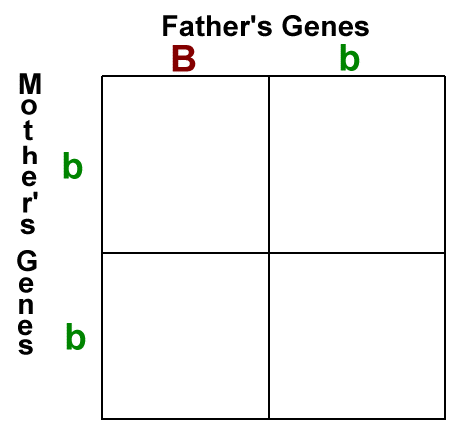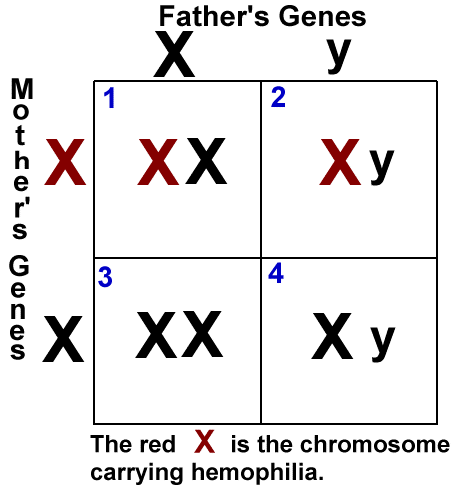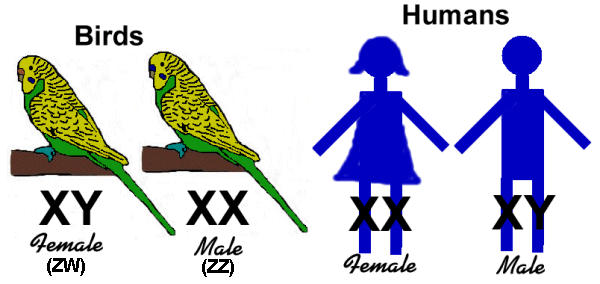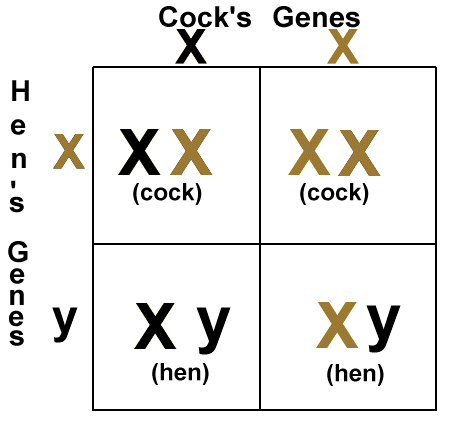Disclaimer: This guide is meant to be a very basic overview of these topics. Terms are kept as generic as possible, and some things are vastly oversimplified.

Photo by Jeff Coffman
Part 1: Genetics
Physical characteristics are controlled by genes. We get two sets of genes from our parents. If our parents both have brown eyes, we will likely have brown eyes too. But what happens when one of our parents has blue eyes and the other has brown? What color will our eyes be? Both genes will not be displayed at the same time. Our body controls which genes show up through gene expression. There are several kinds of gene expression, but dominant, recessive, and sex-linked are the three we’ll worry about.
Dominant and Recessive Genes
A dominant gene is expressed no matter what. If your body contains a single copy it will show up visually. A recessive gene can only be displayed if BOTH the genes received from the parents are the same recessive gene. Think of it this way: a dominant gene is like the sun and recessive genes are like the stars. If the sun is in the sky, the stars cannot be seen even though they are there. Likewise, when a dominant gene is present the recessive genes are all hidden. But if there are no dominant genes around we can see recessive genes.
In humans, the gene for brown eyes is dominant and the gene for blue eyes is recessive. So if we received one brown gene from dad and one blue gene from mom only the brown gene would be expressed. Our eyes would be brown.

The only way to get blue eyes is if you get TWO copies of the gene for blue eyes.

So far all of our examples have carried two copies of the same gene. Not all parents are like this. When a brown-eyed person and a blue-eyed person have a child, even though that child has brown eyes they still carry the gene for blue. What if that child decides to have children? Which gene will they inherit? Luckily, there is an easy method to find out.
A Punnett square (below) is a quick way to find out the chances of a child inheriting a certain gene. The father’s genes are each entered at the top and the mother’s genes are entered on the side. The four boxes in the center are the possible combinations of those genes. Let’s try one together.
First, draw a square like the one below.

Our father here will be a man with brown eyes who carries the gene for blue. Mom will have blue eyes.

Enter the information on the parents. We use capital letters to symbolize dominant genes (in this case a capital “B” for brown), and lower case letters to symbolize recessive genes (in this case a little “b” for blue).

Now we combine the parents’ genetic information in the boxes to find out how the children will look.

The results out of four children:
- two are Bb (brown eyes, carrying gene for blue)
- two are bb (blue eyes)
Let’s try some more. What if both parents have brown eyes, but carry the gene for blue? You’d get the following:

Results:
- one BB (brown eyes)
- two Bb (brown eyes, carry blue)
- one bb (blue eyes)
Now let’s see if you can do some on your own:


Give yourself a big pat on the back if you got them right. Now we can move on to the third form of gene expression…
Sex-linked Genes
Sex-linked genes act just like recessive, except they also bow to the will of the sex of the child. To understand sex-linked genes, it helps to know what they look like. Genes are just sections of DNA code that tell the body to do something. DNA itself is coiled tightly and contained in a structure called a chromosome.

Most people already know that in humans the man has an X and Y chromosome and the female has two X chromosomes. This is the reason that the only the man can determine the sex of the child. Women can only provide X chromosomes while a man can provide either. The X chromosome is physically bigger and can carry more genetic information on it than the Y chromosome. This is where sex-linked traits come in. Because the X is bigger it means that some genes carried on it are not carried on the Y chromosome. These genes can be expressed even without a corresponding partner on an X chromosome. They also cannot be blocked out unless there is another X chromosome carrying a dominant partner.

One human sex-linked gene is hemophilia. Hemophilia is a disease that keeps a person’s blood from clotting when they are cut. Because hemophilia is a sex-linked disease, most of the people who have it are men. Women can carry the gene for hemophilia but will not be affected by it because their second X chromosome will block it out with a healthy gene. Women must have two copies of the defective gene to be affected by the disease. Inheriting two copies is highly unlikely. Since a man only has one X chromosome (from his mother), if he gets a copy of the gene he will have the disease. Mothers carrying one gene for hemophilia have a 50% chance of sons being born with the disease. Here’s how it works:

As you can see, at least half of her children (boxes 1 and 2) will inherit the gene. One, a daughter, will only carry the gene. The other, a son, will have the disease hemophilia. The last two children (boxes 3 and 4) will carry healthy genes. Of course these are only the possibilities of what her children could end up with. She could very well end up giving it to all her children or none at all. It’s just a matter of chance. Now let’s take a look at what will happen if this woman’s hemophiliac son has children with a healthy woman:

ALL the man’s daughters will be carriers and all of his sons will be safe. The daughters could end up passing it on to their children. It is in this way that sex-linked genes can disappear and reappear from generation to generation.
Not all sex-linked traits are bad. Many of the colors you see in birds like lutino, pearl, and cinnamon are controlled by sex-linked genes. But before we can get into bird sex-linked traits there’s something you need to know: BIRDS DO NOT HAVE X AND Y CHROMOSOMES. Birds carry different sex chromosomes than humans. Instead of X and Y, they have Z and W. That’s not really important and we’ll stick to X and Y for our examples here. What IS important is that in birds the male carries two of the same chromosome (like XX) and the female carries two different (XY). This means that it is hens who determine the sex of the chicks in birds and that they are more likely to show up with sex-linked traits. The punnett squares and such all work the same way, you just have to remember to reverse the X and Y’s from that of humans:

Let’s try another punnet square, this time for birds. I have a lutino male and I want to see what I’ll get if I breed him to a normal hen. In order for a male to display lutino he has to be carrying it on both X chromosomes. We’ll color the lutino X’s with yellow to tell them apart.

All of the babies will be carrying a gene for lutino. The cocks, however, will only be “split” (carry the gene) and will not show up lutino. The hens will all be visually lutino because they have no second X chromosomes to block out the gene.
The results:
- 50% normal males split for lutino
- 50% lutino hens
Let’s try one more. This time I want to mate a cinnamon hen to a cock split to cinnamon (carrying but not displaying). She will only need the one gene to show the color.

Half of the babies will be cinnamon (both sexes), one will be split (a male) and one will be normal (female).
The results:
- 25% normal males split to cinnamon
- 25% cinnamon males
- 25% cinnamon females
- 25% normal females.
One of the great things about sex-linked traits is that they may allow you to sex birds very young without having to DNA test. A male that is carrying lutino, when mated with a hen that is not lutino, will always have lutino daughters. If he is lutino himself then ALL his daughters will be lutino. If he is not visibly lutino then any lutino you find in the nest will be a hen for certain.
Sex-linked genes allow you to get visual colors much faster, as you only need a male to be carrying a single copy. This is why Pineapple green cheek conures are more common than colors like turquoise. Pineapple is a combination of two sex-linked colors, while turquoise is recessive. However, it also drives up the price of males who show sex-linked traits. Hens are far easier to come by. To get a visual male you need two copies of the gene.
Well that’s it for now. Congratulations, you survived part one!
All articles and images contained on this site are ©2017 by Karen Trinkaus and may not be reprinted or used in any way without the author’s permission.